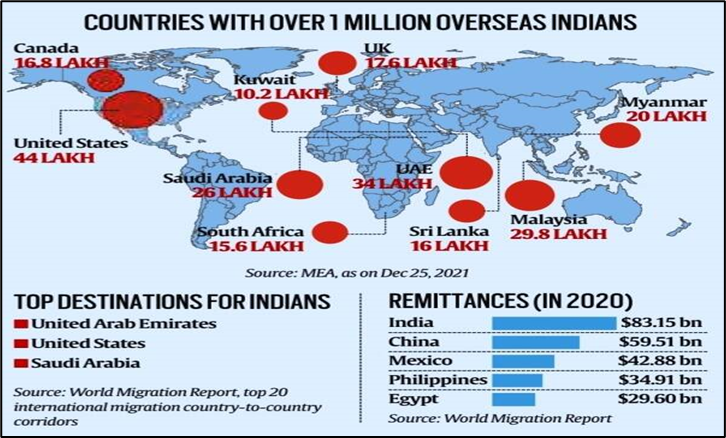Why in News?
- The Prime Minister of India recently inaugurated the 17th Pravasi Bharatiya Divas (PBD) convention in Indore (Madhya Pradesh), saying that Indians living abroad are brand ambassadors for the country on foreign soil.
What’s in today’s article?
- What is the history of the Indian diaspora?
- How is the Indian diaspora classified?
- What is the size and geographical distribution of the Indian diaspora?
- What is the amount of money they send back to India (remittances)?
- News Summary
What is the history of the Indian diaspora?
- ‘Girmitiya’ arrangement: The Indian diaspora has grown manifold since the first batch of Indians were taken to counties in the east pacific and the Caribbean islands as indentured labourers.
- They were shipped to these countries in the 19th and early 20th centuries to work on plantations in British colonies that were reeling from a labour crisis following the abolition of slavery in 1833-34.
- Waves of migration: In the 2nd wave, nearly 20 lakh Indians went to Singapore and Malaysia to work in farms, while the 3rd and 4th wave saw professionals heading to western countries and workers going to the Gulf and west Asian countries in the wake of the oil boom.
How is the Indian diaspora classified?
- Overseas Indians are classified into 3 categories: Non-Resident Indians (NRIs are Indians who are residents of foreign countries), Persons of Indian Origin (PIOs), Overseas Citizens of India (OCIs).
- According to the MEA, PIO refers to a foreign citizen (except a national of Pakistan, Afghanistan Bangladesh, China, Iran, Bhutan, Sri Lanka and Nepal) -
- who at any time held an Indian passport, or
- who or either of their parents/grandparents/great grandparents was born and permanently resided in India as defined in Government of India Act, 1935, or
- who is a spouse of a citizen of India or a PIO
- A separate category of OCI was carved out in 2006. An OCI card was given to a foreign national -
- who was eligible to be a citizen of India on January 26, 1950,
- was a citizen of India on or at any time after January 26, 1950, or
- belonged to a territory that became part of India after August 15, 1947
- Minor children of such individuals, except those who were a citizen of Pakistan or Bangladesh, were also eligible for OCI cards.
- The PIO category was abolished in 2015 and merged with the OCI category.
What is the size and geographical distribution of the Indian diaspora?

- According to the Parliamentary committee on external affairs, there were 7 crore Indians (NRIs - 1.35 crore, PIOs - 1.87 crore, OCIs, and students) living overseas (as on December 31, 2021). Excluding students, the number stands at 3.22 crore.
- According to the World Migration Report, prepared by the International Organisation for Migration under the United Nations, India has the largest emigrant population in the world, making it the top origin country globally, followed by Mexico, Russian and China.
What is the amount of money they send back to India (remittances)?
- The WB’s Migration and Development Brief 2022, noted that India, China, Mexico, the Philippines and Egypt are (in descending order) among the top 5 remittance recipient countries, although India and China were well above the rest.
- The report stated that for the first time a single country (India) is on track to receive more than $100 billion in yearly remittances.
News Summary:
- Significance of Indian diaspora:
- When the PBD was launched in 2003, then PM Atal Bihari Vajpayee noted that overseas Indians can project the truth about India to the world in a credible and effective manner and counter propaganda.
- In his speech, the Indian PM recently urged Pravasi Bharatiyas to amplify India’s development story.
- What more can be done?
- The vocal political positions taken by a segment of the Indian diaspora, particularly in the US and the UK, are a relatively new phenomenon.
- However, the Parliamentary Committee pointed out that conventions such as the Pravasi Bharatiya Sammelan appear to be leaving out a large section of the diaspora that is not wealthy.
- The low/semi-skilled and blue-collar workers may not find a place or feel comfortable to participate in the said celebration as the general profile of participants is seen to be of very high level.
- The Committee has a strong view that the participation and involvement should be more broad-based, accommodating the vulnerable sections of the diaspora community too.









